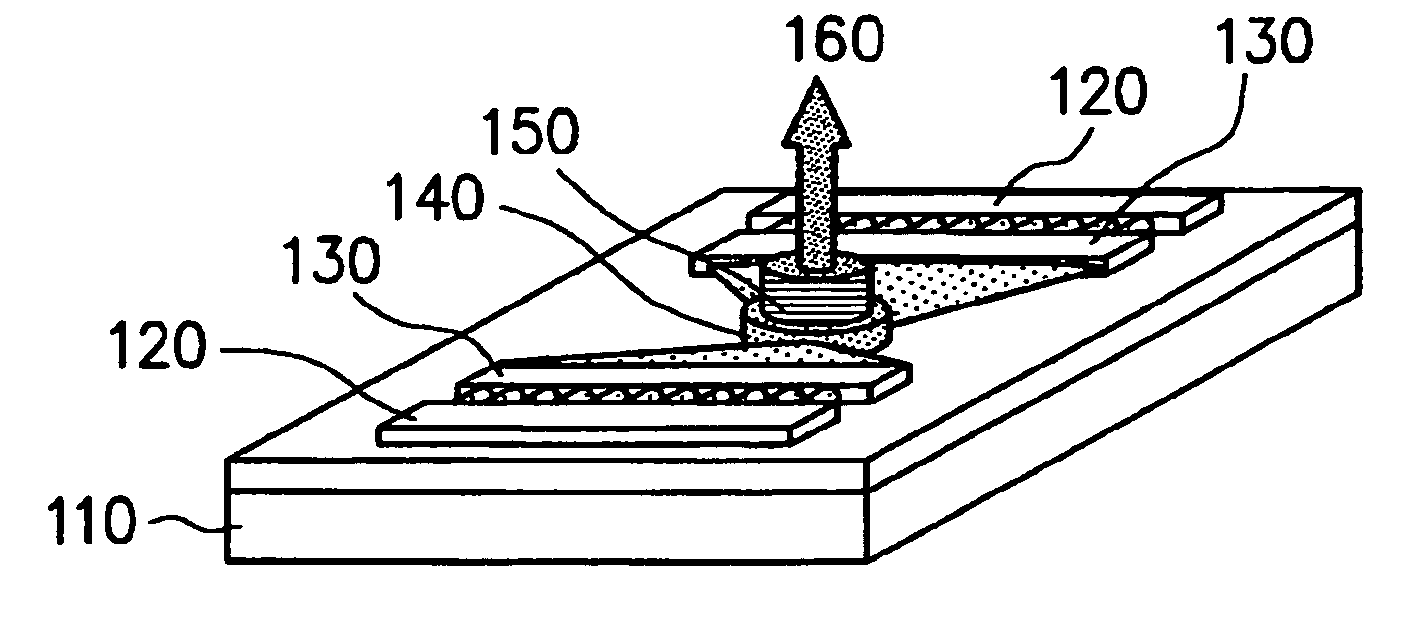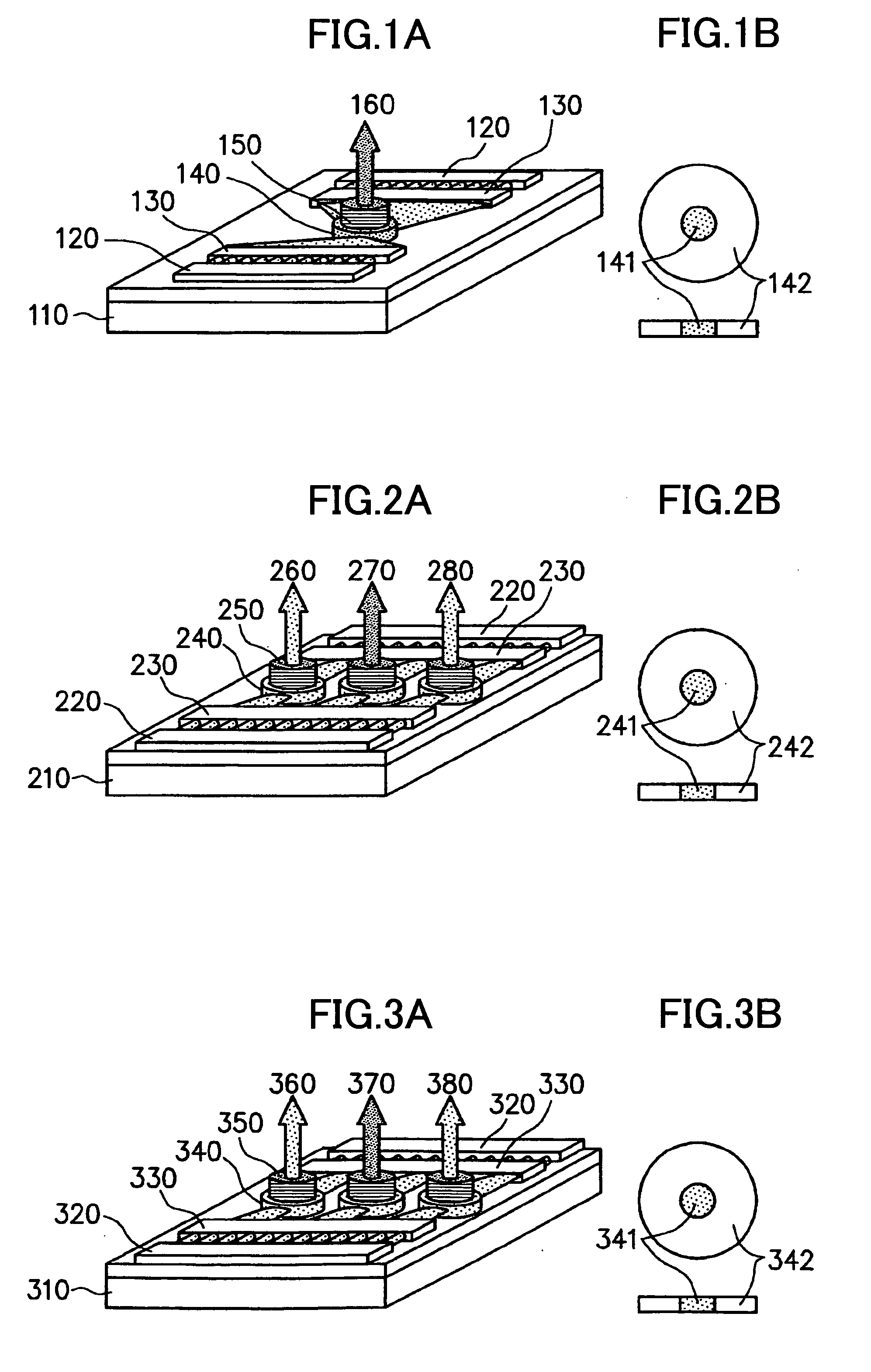Solid-state laser pumped by semiconductor laser array
a laser array and solid-state technology, applied in the field of laser technology, can solve the problems of limited heat dissipation efficiency, increased laser number, and increased optical source size, and achieve the effect of improving laser oscillation efficiency and low cos
- Summary
- Abstract
- Description
- Claims
- Application Information
AI Technical Summary
Benefits of technology
Problems solved by technology
Method used
Image
Examples
example 1
[0083] First, Example 1 will be explained with reference to FIGS. 1A and 1B, wherein FIG. 1A is a diagram showing the construction of the solid-state laser of the present example, while FIG. 1B shows the solid-state laser medium used in the solid-state laser of FIG. 1A in a front view and a side view.
[0084] Referring to FIG. 1A, the solid-laser apparatus of Example 1 is constructed on a mounting substrate 110 and includes, on the mounting substrate 110, semiconductor laser arrays 120 for pumping, microlens elements 130 cooperating with the respective semiconductor laser arrays 120, a solid-state laser medium 140 and a wavelength conversion element 150.
[0085] In the present example, the mounting substrate 110 comprises a flat substrate of aluminum nitride having a size of 50×50 mm and a thickness of 5 mm.
[0086] Thereby, it will be noted that there are disposed two semiconductor laser array elements 120, each producing an optical output of 20 W at the wavelength of 808 nm, on the m...
example 2
[0109] Next, Example 2 of the present invention will be described with reference to FIGS. 2A and 2B, wherein FIG. 2A shows the construction of the solid-state laser apparatus of the present embodiment, while FIG. 2B shows the laser medium used with the laser apparatus of FIG. 2A in a front view and a side view.
[0110] Referring to Embodiment 2, the laser apparatus is constructed on a mounting substrate 210 and includes a semiconductor laser array 220, microlenses 230, a laser medium 240 and a wavelength conversion element 250, wherein the laser arrays 220, the microlenses 230 and the laser medium 240 are all mounted directly on the mounting substrate 210. The wavelength conversion element 250 is provided on the laser medium 240.
[0111] Here, it should be noted that the mounting substrate 210 comprises a flat board of an aluminum nitride having a size of 50×50 mm and a thickness of 5 mm.
[0112] On the other hand, the semiconductor laser array 220 produces a pumping laser beam with th...
example 3
[0151] Next, Example 3 will be explained with reference to FIGS. 3A and 3B, wherein FIG. 3A is a diagram showing the construction of the solid-state laser of the present example, while FIG. 3B shows the solid-state laser medium used in the solid-state laser of FIG. 3A in a front view and a side view.
[0152] Referring to FIG. 3A, the solid-laser apparatus of Example 3 is constructed on a mounting substrate 310 and includes, on the mounting substrate 310, semiconductor laser arrays 320 for pumping, microlens elements 330 cooperating with the respective semiconductor laser arrays 320, a solid-state laser medium 340 and a wavelength conversion element 350.
[0153] In the present example, the mounting substrate 310 comprises a flat substrate of aluminum nitride having a size of 50×50 mm and a thickness of 5 mm.
[0154] Thereby, it will be noted that there are disposed two semiconductor laser array elements 320, each producing an optical output of 30 W at the wavelength of 808 nm, on the mo...
PUM
 Login to View More
Login to View More Abstract
Description
Claims
Application Information
 Login to View More
Login to View More - R&D
- Intellectual Property
- Life Sciences
- Materials
- Tech Scout
- Unparalleled Data Quality
- Higher Quality Content
- 60% Fewer Hallucinations
Browse by: Latest US Patents, China's latest patents, Technical Efficacy Thesaurus, Application Domain, Technology Topic, Popular Technical Reports.
© 2025 PatSnap. All rights reserved.Legal|Privacy policy|Modern Slavery Act Transparency Statement|Sitemap|About US| Contact US: help@patsnap.com



